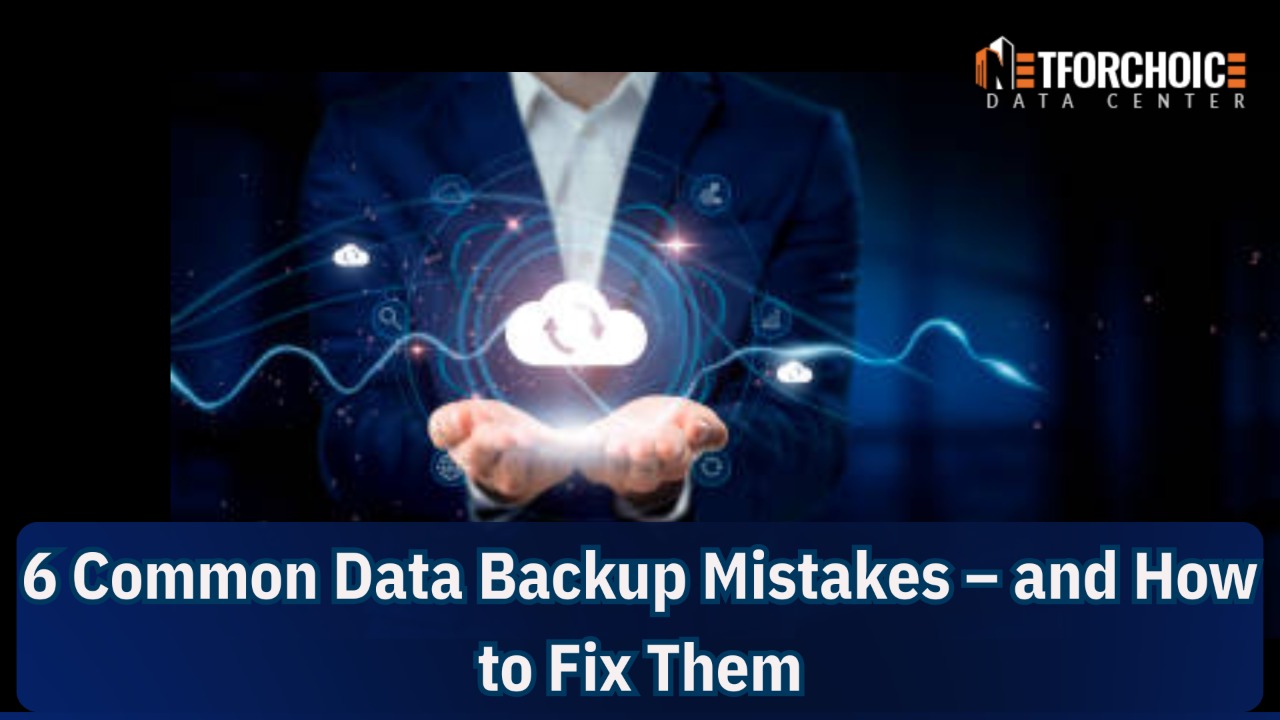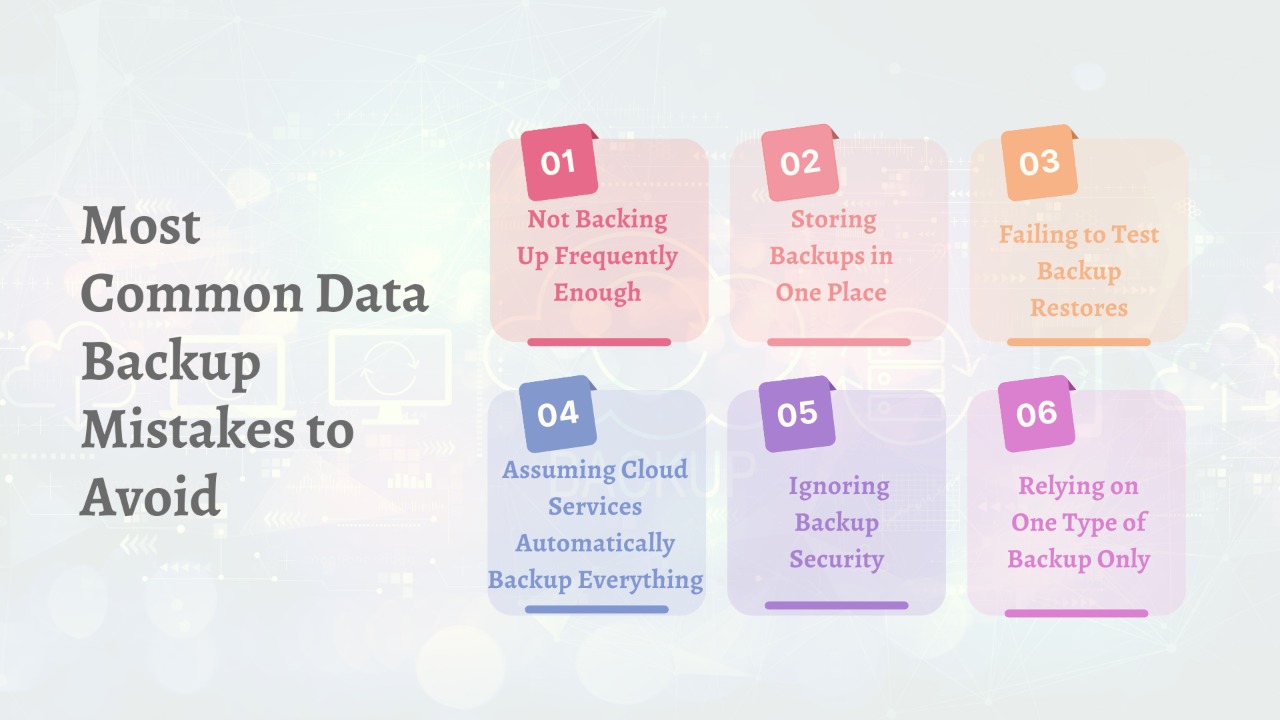6 Common Data Backup Mistakes – and How to Fix Them

Your data is not always completely safe just because you have a backup plan in place. Despite investing in backup solutions, many businesses unintentionally make crucial errors that jeopardize their data and business continuity. These mistakes can have serious repercussions, ranging from skipping routine testing to depending solely on cloud storage.
Data backup is now an essential part of an organization’s overall data protection and disaster recovery plan, not just an optional precaution.
We will examine six of the most frequent data backup errors in this blog and offer workable fixes to assist companies in successfully reducing these risks.

1. Not Backing Up Frequently Enough
The Mistake
Data never remains static—changes occur daily with e-mail, customer records, financial transactions, and project files. If you back up weekly or monthly, a system crash or an attack from malware could wipe out days or weeks of important data..
The Fix
There should be automated, real-time backups or a schedule should be in place so that a daily backup is conducted. Automation ensures that backups aren’t forgotten and that data is always up-to-date. Depending on the storage available for the backup, differential or incremental backups would also come into play for fresh data.
Frequent backups are the only way to mitigate any data loss and reduce downtime or disruption due to inadvertent deletion or corruption. In industries like finance, healthcare, or e-commerce, even a few hours of data loss could lead to huge ramifications in terms of financial penalties, compliance issues, or customer dissatisfaction.
2. Storing Backups in One Place
The Mistake
Keeping your backups on the same server or physical location as your main data creates a single point of failure. If that system is compromised by ransomware, fire, or hardware failure, both your primary and backup data are at risk.
The Fix
Follow the 3-2-1 backup rule: Keep three copies of your data, store two on different storage types, and one offsite—either in the cloud or a separate data center.
Hybrid approaches that utilize both on-premise and cloud solutions are becoming more common due to their flexibility and speed. If disaster strikes, offsite or cloud backups allow businesses to restore operations quickly, even if physical infrastructure is damaged.
3. Failing to Test Backup Restores
The Mistake
Having a backup doesn’t guarantee a successful restore. When disaster strikes, many businesses discover that their backup files are corrupted, incomplete, or incompatible.
The Fix
Regularly test your backup restore process. Simulate data loss scenarios to make sure you can recover quickly and completely. These tests uncover technical issues and give your team confidence when it matters most.
Without regular testing, businesses may find themselves scrambling to recover lost data, only to realize their backups are ineffective. A solid backup plan is only as good as its ability to restore data when needed.
Also Read: Why Is Public Cloud Backup Important For Companies?
4. Assuming Cloud Services Automatically Backup Everything
The Mistake
Having your files in Microsoft 365, Google Workspace, or Dropbox does not mean they are backed up. It is not treated as a full disaster recovery tool or a long term data archiving service, however, as retention is limited.
The Fix
Implement a third-party cloud backup designed for SaaS services. They offer long-term retention, point-in-time recovery, protection, and additional layers of security.
Business data stored in the cloud needs the same level of protection as on-premise data. A well-rounded cloud backup solution ensures that information is retrievable even after accidental deletions, malicious attacks, or compliance-related requirements.
5. Ignoring Backup Security
The Mistake
If you fail to secure the data, the backups can become the weakest link. Backup are not only the final lifeline for companies, but also something that cybercriminals can see as very interesting and valuable, too. Vulnerabilities such as unencrypted backups or poorly protected access points, however, can result in catastrophic data breaches.
The Fix
Upgrade Backup Storage Encrypted in Transmission and at Rest Ensure role-based access, multi-factor authentication, and track access logs. Use a Backup Provider That Meets Data Protection Standards (GDPR, HIPAA)
Ransomware attacks have become increasingly sophisticated, with some variants specifically targeting backup files. Implementing air-gapped backups—stored in isolated environments—adds another layer of security against such threats.
Also Read: VPS Server Backup Solution for Businesses
6. Relying on One Type of Backup Only
The Mistake
You are stuck with only full backups, or count only on cloud storage, which limits your flexibility. This also slows down the restore process and can make it costlier in a large-scale recovery.
The Fix
Create a hybrid backup plan. Use the full, incremental, and differential backup for the best performance. Take advantage of local backups for quick and cloud backups for offsite protection.
A diverse backup strategy ensures that businesses can recover quickly, regardless of the type of data loss scenario they face. Organizations should tailor their backup methods to their operational needs, ensuring that critical data is accessible when necessary.
How NetForChoice Helps You Avoid These Mistakes?
At NetForChoice, we understand that data backup is not just about storing copies—it’s about ensuring data resilience, security, and accessibility. That’s why we offer Acronis and Vaultize, two industry-leading backup solutions tailored for businesses of all sizes.
Acronis Backup Solutions-
- Automated backups with flexible scheduling
- Cloud, on-premise, and hybrid storage options
- Advanced ransomware protection
- Fast and reliable data recovery
Vaultize Backup & Endpoint Security-
- Real-time backup for endpoint devices
- Encrypted data sharing with enhanced access controls
- Granular file restore options for specific data recovery
With NetForChoice, businesses gain access to enterprise-grade backup solutions without the complexity of managing them in-house. Our experts help customize backup strategies that align with regulatory requirements and operational needs, ensuring peace of mind and business continuity.
Final Thoughts
Your backup system should be your safety net—not your weak link. Ignoring any of these common mistakes could cost you time, money, and trust. But the good news is, with the right tools and practices, you can build a foolproof strategy that keeps your business running no matter what.
At NetForChoice, we help organizations build robust backup strategies with Acronis and Vaultize, ensuring your data remains secure, accessible, and protected against all threats.
Avoid costly errors and stay ahead of disasters—partner with NetForChoice and build a smarter, stronger backup strategy today.
FAQ”s
Question: What is data backup solution?
Answer: Data Backup is the process of making a copy of your digitized data and other business information in case your data is damaged, deleted or lost. The backup copy is then used to recover or restore your data for business continuity and disaster recovery.
Question: What are the four 4 types of backup systems?
Answer: The most common backup types are a full backup, incremental backup and differential backup. Other backup types include synthetic full backups and mirroring.
Question: What is a backup solution?
Answer: The main role of backup solutions is to enable access to important data when there’s unexpected IT or business disruption such as a natural disaster (e.g., fire, flood, hurricane), system failure, ransomware attack, or insider threat.
Still Confused Contact the Expert
Submit Your Query

